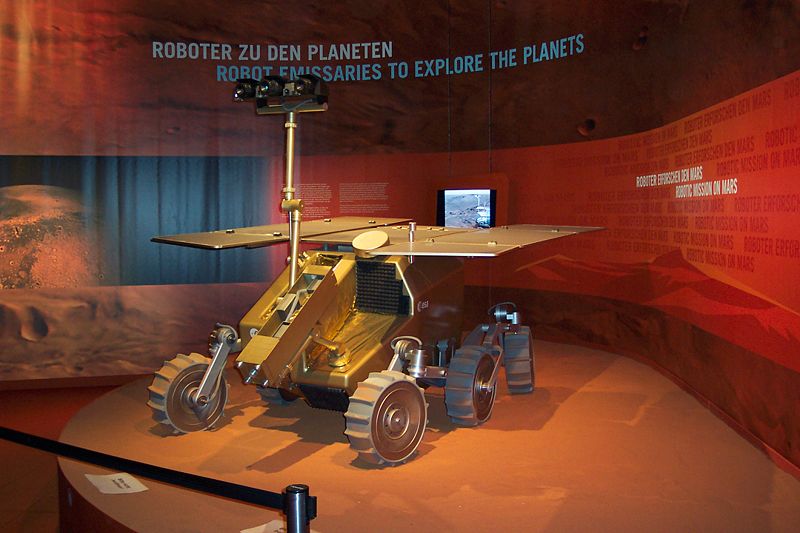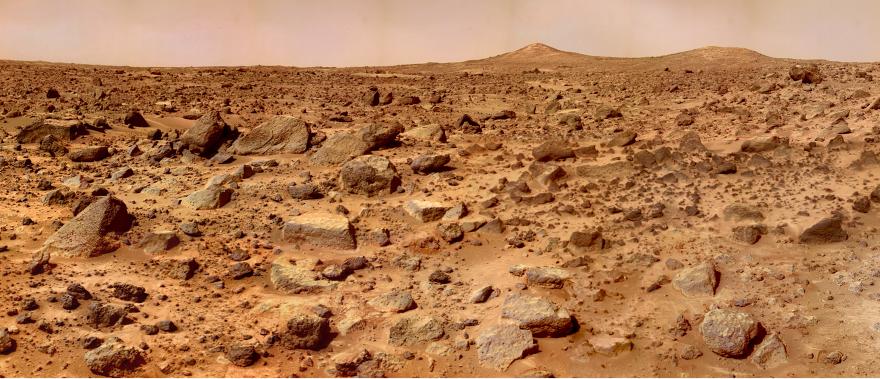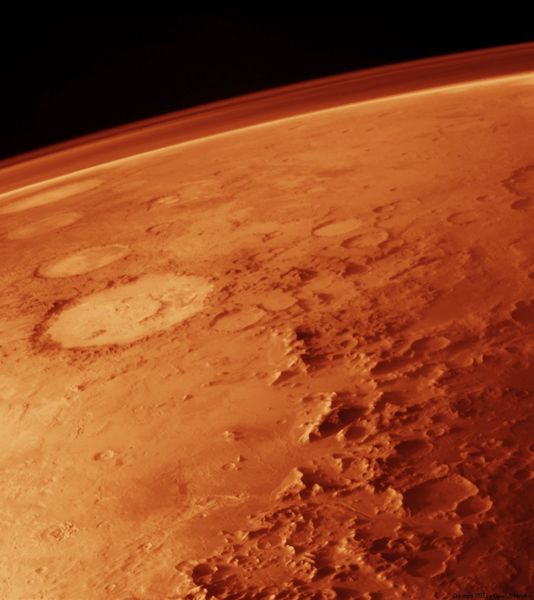ExoMars and Manned Mars Missions
Interview with
John - So here we have the ExoMars engineering prototype. Six-wheel drive rugged all-terrain vehicle which can go up and down 45 degree slopes and over large boulders. Ideal for Mars. We're developing the science instruments like the stereo cameras so we can build up three-dimensional views of Mars' surface and look at the rocks and decide how they forms.
Meera - Will it be taking any actual samples and analysing them?
 John - It has about 25kg of science instruments: different spectrometers to look at the chemical compositions of the rocks and the mineralogy so we can find chemical and mineral signatures or water on Mars or life on Mars. This is a real motivational factor for scientists and, I think, really the population at large to ask the big question - was there ever life elsewhere in the solar system? If we're going to address that question we need rovers like this with lots of science instruments.
John - It has about 25kg of science instruments: different spectrometers to look at the chemical compositions of the rocks and the mineralogy so we can find chemical and mineral signatures or water on Mars or life on Mars. This is a real motivational factor for scientists and, I think, really the population at large to ask the big question - was there ever life elsewhere in the solar system? If we're going to address that question we need rovers like this with lots of science instruments.
Meera - What will ExoMars be exploring?
John - ExoMars will go to a new place on Mars where no one has been to before. It'll be looking at rocks, looking at textures, using a microscope, looking at subsurface structure with our seismometer, finding out how the rocks were deposited. Were they deposited from water or from wind? As we piece together bits of information like that we find out what was happening on Mars millions of years ago. Today Mars is cold and dry. Millions of years ago, or billions of years ago, we think that it was probably warm and wet but we don't know for how long it was warm and wet. These are important questions to find out about Mars if you want to answer ultimately was there ever life on Mars and why did climate change on Mars from warm and wet to cold and dry.
Meera - When is ExoMars set to go?
John - 2013. It'll take nine months to get there. How do you actually go about testing this to make sure it will work and survive on Mars? For instance, the engineers from Astrium who are building the ExoMars prototype take it out to Tenerife and they practise with it over all sorts of rocky terrains to simulate the Mars surface going up and down 45 degree slopes, over rocky terrains: making sure it can do what we need it to do on Mars.
Meera - How about the environmental conditions of temperature and things like that?
 John - Mars is a really extreme environment. The average surface temperature on Mars is about -60 degrees centigrade. At the poles on Mars it can go down to -140 degrees centigrade. Just to put that in context, the lowest ever recorded temperature on Earth is about -80 degrees centigrade. It's a very cold and very dry place. Also, the atmosphere is very thin. It's about a thousandth of the atmospheric pressure of that on the Earth. That means a lot of the radiation from the sun can get through to Mars which would actually be stopped on Earth. It's much more harsh radiation environment. That means organic compounds are broken down on the Mars surface whereas on Earth they would be preserved. That's why we've got a drill on ExoMars so that we can get down fairly deep into the subsurface into areas which haven't been cooked, if you like, by the sun's radiation.
John - Mars is a really extreme environment. The average surface temperature on Mars is about -60 degrees centigrade. At the poles on Mars it can go down to -140 degrees centigrade. Just to put that in context, the lowest ever recorded temperature on Earth is about -80 degrees centigrade. It's a very cold and very dry place. Also, the atmosphere is very thin. It's about a thousandth of the atmospheric pressure of that on the Earth. That means a lot of the radiation from the sun can get through to Mars which would actually be stopped on Earth. It's much more harsh radiation environment. That means organic compounds are broken down on the Mars surface whereas on Earth they would be preserved. That's why we've got a drill on ExoMars so that we can get down fairly deep into the subsurface into areas which haven't been cooked, if you like, by the sun's radiation.
Meera - Are robotics the future of space exploration?
John - That's the question we're posing today because our exhibit is called 'Exploring the Solar System: Mankind or Machine?' Should we continue with robots and get lots of great science but should we also perhaps have an astronaut training programme? We're trying to engage here what people think. We've got a little pole here and what we've found this week is that the majority of people think that we should explore the solar system both by mankind and machine. We should have both.
Meera - What are the benefits of humans and the benefits of robots?
 John - Robots perhaps you get more science for your money, if you like, immediately. It's less risky. You're not going to risk people's lives. You can send probes perhaps into the really extreme, cold environments or hot environments that would be very difficult to send people. Certainly over the next 10-20 years on Mars it's going to be dominated by robotic exploration. In the first samples we bring back from Mars it'll be done robotically. We can start doing tests with rovers and with samples brought back from Mars within the next 20 years. There can be benefits with sending people because they're such flexible machines, if you like. The autonomy, it'll be a long time before robots have that. The sheer scale of the endeavour to get people there will always mean that it is going to take longer. Talking to the people that have come to the exhibit and asking them, 'why do you think we should also send men?' I think what you might describe as a frontier spirit. It's about exploration, difficult to quantify in terms of absolute science but in terms of exploring the solar system there's a real drive, real excitement about man walking on the moon or perhaps ultimately walking on Mars. I think that's a powerful driving force. Even if it isn't purely scientific I don't think you can dismiss that. I think exploring by mankind: yes, we should do it but for me it's more of an exploration thing rather than purely scientific. It's great but it's not just about science.
John - Robots perhaps you get more science for your money, if you like, immediately. It's less risky. You're not going to risk people's lives. You can send probes perhaps into the really extreme, cold environments or hot environments that would be very difficult to send people. Certainly over the next 10-20 years on Mars it's going to be dominated by robotic exploration. In the first samples we bring back from Mars it'll be done robotically. We can start doing tests with rovers and with samples brought back from Mars within the next 20 years. There can be benefits with sending people because they're such flexible machines, if you like. The autonomy, it'll be a long time before robots have that. The sheer scale of the endeavour to get people there will always mean that it is going to take longer. Talking to the people that have come to the exhibit and asking them, 'why do you think we should also send men?' I think what you might describe as a frontier spirit. It's about exploration, difficult to quantify in terms of absolute science but in terms of exploring the solar system there's a real drive, real excitement about man walking on the moon or perhaps ultimately walking on Mars. I think that's a powerful driving force. Even if it isn't purely scientific I don't think you can dismiss that. I think exploring by mankind: yes, we should do it but for me it's more of an exploration thing rather than purely scientific. It's great but it's not just about science.









Comments
Add a comment